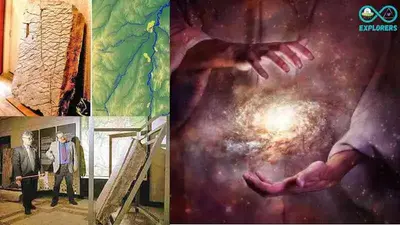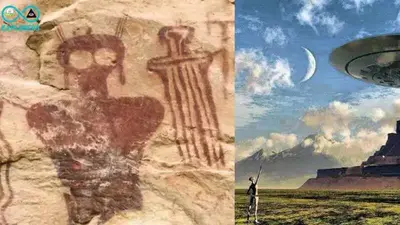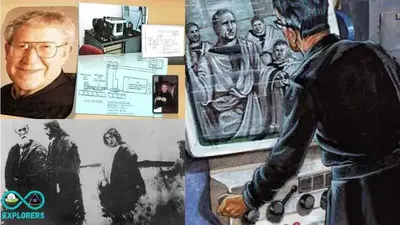Paranormal Activity
The Lost Years of Jesus Christ in India: Connection Between Hinduism And Jesus
The gospels contain remarkably little information about the early life of Jesus Christ. Only four of the eighty-nine chapters of the Gospels—two each in Matthew and Luke—describe the life of Jesus before his ministry. Let’s take a look into the lost years of Jesus Christ in India and his connection with Hinduism.

According to Matthew, Joseph and Mary fled to Egypt when Jesus was an infant and returned to Nazareth after the death of Herod in 4 AD. A brief mention in the Gospel of Luke says that when Jesus was twelve years old, Joseph and Mary went to Jerusalem for the Passover feast.
On their way back to Nazareth, they realized that Jesus was not with them. They returned to Jerusalem in search of him and found him “sitting among the teachers, listening to them and asking them questions, and all who listened to him were amazed at his understanding and his answers.”
And this is the last thing we hear in the Bible about the childhood of Jesus.
The next time he appears in the Gospels, he is in his thirties and is traveling from Galilee to the Jordan River to be baptized by John. Absolutely nothing is known about what happened to him during those 18 years, from twelve to thirty, the so-called “lost years of Jesus.”
Only one line in the Gospel of Luke sums up Jesus’ activities during those years: “And Jesus grew [in] wisdom and stature and favor with God and men.”
Theologians generally assume that Jesus may have lived in the vicinity of Nazareth during this period and did nothing of note to report. But this is very unlikely because a person like Jesus would easily stand out in the crowd in the best years of his life.
In addition, a person simply cannot perform amazing healings and other miracles without at least some training from one or more teachers. And certainly, Jesus would not have spent the best years of his life learning, tinkering around his father’s carpenter’s barn when his mind was obviously set on gaining wisdom.
In 1894, the Russian writer Nikolai Alexandrovich Notovich created a sensation by publishing a book called The Unknown Life of Jesus Christ, in which he claimed that, according to ancient Buddhist manuscripts at the Hemis Monastery in Ladakh, India, Jesus Traveled through India and Nepal for of their “lost years” by learning from Hindu and Buddhist masters and preaching to the people.

Notovitch’s account was later corroborated by the testimony of the Indian mystic Swami Abhedananda, who walked to Hemis in 1922 and questioned the lama about Jesus.
A little later, the Russian archaeologist, artist, and philosopher Nicholas Roerich undertook a large-scale expedition to Central Asia in 1924-1928 and found there many variants of the legend of Jesus Christ, told by people in Kashmir, Ladakh, and Central Asia.
In the West, this epic saga of exploration and discovery in the cold, barren upper Himalayas, spanning almost half a century, was documented in detail by the American writer Elizabeth Clare Prophet in The Lost Years of Jesus (1984).
Below we will take a closer look at some of the evidence of Jesus’ sojourn in the East documented by these people.
Table of Contents
Notovitch’s Discovery Regarding The Lost Years Of Jesus Christ
Nikolai Notovich set off on his journey in 1887 and reached Ladakh the same year, passing through Afghanistan, Rawalpindi, and Kashmir. On his way to Leh, he visited the Mulbeh Monastery in Kargil, which is picturesquely located on the top of an isolated rock. There the lama told him about the prophet Issa (Isa is the name of Jesus in Arabic, while Issa is his name in India), in whom the spirit of God was embodied.
Jesus Christ And Buddhism

“It was he who enlightened you, returned the souls of the frivolous to the framework of religion, and allowed every human being to distinguish between good and evil. His name and his deeds are recorded in our sacred scriptures,” said the lama.
The lama went on to say that the main manuscripts containing the stories of Issa were written in India and Nepal in the Pali language and are kept in Lhasa, Tibet. Some of the main monasteries contain copies of these scrolls in Tibetan.
The conversation piqued Notovitch’s curiosity, and he decided to travel to Tibet one day to get more information about Jesus’ visit to these remote regions.
Reaching the Hemis Monastery in Ladakh, which is hidden in a hidden valley at a high altitude, Notovitch asked the head lama if he had ever heard of Issa. The lama said that Issa’s name is highly respected by Buddhists, but only the lamas who have read the sacred scrolls know about it.
He explained that there are several manuscripts in the Hemis monastery:
“Among them may be found descriptions of the life and deeds of the Buddha Issa, who preached the holy doctrine in India and among the children of Israel, and who was put to death by the pagans, whose descendants have since adopted the principles which he then propagated, which we believe are yours. “.
Then the lama continued:
“When the holy child was still a boy, he was taken to India, where until he came of age he studied the laws of the great Buddha, who forever resides in heaven.”
The lama also told Notovitch that a copy of the life of Issa was somewhere in the Hemis Monastery and he would be happy to show it to Notovitch if he visited the gompa again.

Photo credit: Michael Day /CC BY 2.0
Notovitch did not want to show too much zeal and arouse the lama’s suspicions. He left Hemis Monastery, planning to return later. But as luck would have it, on the way back he fell off his horse and broke his leg, and used his injury as an excuse to return to Hemis for proper treatment.
His recovery took almost 6 weeks, during which he made several requests to the chief lama, who finally agreed and took out “two large volumes bound with yellowed leaves from time”, and from them, he read to Notovitch a biography of Issa, which consisted of individual verses, randomly scattered throughout the text of the scroll.
Notovitch’s translator translated this story from Tibetan, which the Russian writer wrote down in his notebook. He published a biography of Issa entitled The Life of Saint Issa: Best of the Sons of Men and included it, along with an account of this discovery, in The Unknown Life of Jesus Christ.
Although the Life of Saint Issa is an incredible document, the events leading up to the birth of Issa in Israel do not differ much from the Old and New Testaments. The story takes place in the thirteenth year of Issa’s life, at the age when, according to Jewish custom, an Israelite must marry.
Many rich and noble people came to the threshold of the modest home of his parents, wishing to have young Issa as their son-in-law, who “even then became famous for his edifying speeches in the name of the Almighty.” Issa, however, was “determined to perfect himself in the Divine Word and study the laws of the great Buddhas.”
Life Of Jesus Christ In India
So he secretly left his parents’ home in Jerusalem and went to India with a caravan of merchants. The journey was to follow the Silk Road, and by the time he reached Sindh he was fourteen years old.
Issa crossed all of India and reached the temple of Lord Jagannath (Krishna) in Puri, on the east coast, where the priests joyfully greeted him.
“They taught him to read and understand the Vedas, to heal with prayer, to teach, to explain the Holy Scriptures to people, and to exorcise evil spirits from the bodies of people, returning them to sanity.”

Photo credit: Kalyanpuranand/CC BY-SA 4.0
Jesus Christ in India spent six years in the holy cities of Puri, Rajagriha and Benares (Varanasi), where everyone loved him. But over time, he had a disagreement with the Brahmin priests, who forbade Issa from preaching the Vedic doctrines to the lower castes (Shudras), because, as they said, the Sudras had to serve forever as slaves to the higher castes.
Issa did not want any of this. He told the Brahmins: “God the Father makes no distinction between his children, all are equally dear to him.” “Those who deprive their brothers of divine happiness will themselves be deprived of it,” he instructed the Brahmins.

Photo credit: Marcin Bialek / CC BY-SA 3.0
Issa became aware that his life was in danger, and he fled to the birthplace of the Buddha at Lumbini (Kapilavastu) in Nepal, not far from the foothills of the Himalayas. He perfected himself in the Pali language, devoted himself to the study of the Buddhist sutras, and within six years became a perfect exegete of the scriptures.
During this time he Traveled extensively in the Himalayan ranges and must have visited Kashmir and Ladakh as well since there are persistent rumors that Issa taught there. Some believe that he also visited Tibet at this time, which does not seem likely given that Buddhism only reached Tibet in the 7th century CE and there could be no other reason for Jesus to undertake the extremely difficult journey into Tibet.

Six years later, Issa descended from the mountains to the plains of Rajasthan, from where he went to the west, constantly preaching against idolatry, animal and human sacrifices, and inspiring people to the highest perfection, doing good to their neighbor.
“And Issa further taught the Gentiles not to seek to see the Eternal Spirit with their own eyes, but to try to feel him in their hearts and with purity of soul to make themselves worthy of his graces.”
Issa must have taken the Silk Road through Persia to return back to Israel, as the manuscript says he encountered the Magi in Persia while preaching against sun worship and fire sacrifice.
It is clear that Jesus was a real “instigator”, constantly preaching against the superstitions and injustices of the priestly class, which he continued to do when he reached Israel in his twenty-ninth year.
Thus his sixteen-year sojourn in the East—from the age of thirteen when he left home to the age of twenty-nine—came to an end. And it would not be a mistake to say that by this time he had changed a lot – a saint who had reached the peak of his mental and spiritual abilities and was able to preach, heal and work miracles like no other.
According to Notovitch, it is likely that Indian traders who witnessed the crucifixion in Palestine brought the rest of Issa’s life story to India. However, it is more likely that the Buddhist missionaries who preached in the Mediterranean countries at the time of Christ were the main actors who brought the stories from Palestine and then compared them with the stories of Issa in India, which were probably kept in some of the monasteries.
Notovitch’s book caused quite a stir, to put it mildly. While some acknowledged that his story “may be plausible” and deserves attention, others such as Max Müller were apparently unhappy when they heard about Jesus’ Eastern connections and criticized Notovitch harshly, accusing him of being a liar. who never visited Hemis and fabricated the whole story. Or at least fabricated it, having been deceived by lamas who enjoy misleading inquisitive Travelers.
In those days it was very difficult to get to the monastery of Hemis, which required many days of arduous hiking through difficult mountainous terrain, and thus it was difficult to confirm whether the Issus manuscript actually existed.
The verification problem was exacerbated by the fact that lamas tend to vehemently deny if they have the slightest doubt. Notovitch mentioned in the introduction to his book that the lamas were wary of Westerners, thinking they had come to take their manuscripts.
“The lama says to himself: “If they ask for these manuscripts, it is only to take them away,” so he naturally keeps aloof and refuses any explanations … I knew how to approach the question that interests me from afar while everyone is now asking direct questions,” Notovitch wrote.
This is a fair observation since during the colonial period there was a major theft of artifacts, and the lamas were naturally on their guard.
Notovitch also wrote another sensational piece in the preface to his book. He wrote that he met a cardinal of the Church of Rome (whose name he did not reveal), who told Notovitch the following:
“The unknown life of Jesus Christ is not new to the Church of Rome…. The Vatican Library possesses sixty-three complete or incomplete manuscripts, in various Oriental languages, on this subject, brought to Rome by missionaries from India, China, Egypt, and Arabia.”
Imagine it! If true, this would explain why the Catholic Church maintained a stoic silence after the publication of Notovitch’s book. And why are lamas so afraid that their books will be carried away!
Testimony of Swami Abhedananda Regarding The Life Of Jesus Christ In India
Let us now turn to the journey of Swami Abhedananda (1866-1939), who was a direct disciple of Saint Ramakrishna. Abhedananda’s powers are such that he commands immediate respect.
He spent ten years as an ascetic, Traveling the length and breadth of India on foot, receiving alms, and visiting holy places of pilgrimage, before Traveling to the United States, where he became head of the Vedanta Society in New York.

He spent the next 25 years of his life preaching the wisdom of the Vedic texts and the wisdom of his guru Ramakrishna. Returning to India in 1921, he crossed the Himalayas on foot, first going to Tibet to study Tibetan Buddhism, and then arriving at Hemis Monastery in 1922 with the specific intention of verifying Notovitch’s account.
Abhedananda recorded the events of his journey in a Bengali travel diary called In Kashmir and Tibet, which was published in 1929. It was compiled in part by Abhedanda and in part by his assistant, who worked from his notes and diary. As a result, Abhedananda is often referred to in the third person as “Swamiji” in the text.
According to the book, after the lama showed Abhedananda the monastery, he asked the lama about the veracity of Notovitch’s story, and he learned that the story was indeed true.
“The lama who was showing Swamiji took the Issa manuscript from the shelf and showed it to Swamiji. He said it was a copy and the original was in a monastery in Marbur near Lhasa. The original was written in Pali, but it was a translation into Tibetan. It consisted of 14 chapters and 224 verses. With his help, Swamiji translated part of it.”
The Lama translated the Tibetan manuscript into English, which Abhedananda later translated into Bengali and published in In Kashmir and Tibet. Abhedananda’s description of Jesus’ journey to India is largely the same as Notovitch’s, except that Abhedananda’s account is more concise. This is understandable since Notovitch mentioned that his poems were translated from two separate manuscripts, while the Abhedananda’s source was one manuscript.
The fact that Abhedananda gained access to the manuscript simply by asking about it, unlike Notovitch, who had to literally beg for it, shows that the lamas felt a kind of kinship with Abhedananda, who, like them, was a monk who had left material attachments. and dedicated his life to spiritual pursuits, and could therefore easily trust you.
Abhedananda added an interesting detail to his story that highlights Jesus’ popularity among the common people.
“On the way back to Israel, Jesus stopped at a roadside pond near Kabul to wash his hands and feet and rested for a while. This pond still exists. It is known as the Issa Pond. A fair is held at this site every year to commemorate this event. This is mentioned in the Arabic book Tariq-a-Ajhan.
Abhedananda also supported Notovitch’s assertion regarding the manner in which the manuscript was composed:
“The Reverend Lama said … three or four years after he [Jesus] left his body, that the original manuscript was compiled in Pali from descriptions of all those Tibetans (i.e. Buddhist missionaries) who met him at that time , as well as from the descriptions of merchants who saw with their own eyes his crucifixion by the king of his country.”
Abhedananda’s testimony is an important corroboration of Notovitch’s claim, and given Abhedananda’s authority and authority, it actually confirms the existence of the manuscripts beyond any reasonable doubt.
Shortly thereafter, history took an intriguing turn when the Issus scrolls suddenly disappeared from the monastery of Hemis. In an interview with Richard Bock, Abhedananda’s disciple Swami Prajnananda said:
“I heard from his own lips that he [Abhedananda] saw the scrolls [at Hemis] and translated from them. Many years later he made inquiries, but he was told that the scrolls were no longer there. I also asked to see the scrolls, but there was nothing no. There aren’t any scrolls. They were removed by whom, we don’t know.”
Indeed, very strange! Where were the scrolls moved? Were they deliberately hidden? If yes, why and by whom?
While visiting Hemis in 1974-1975, Tibetologists David Snellgrove and Tadeusz Skorupski were told that Hemis Monastery “certainly has a significant collection (of treasures) locked up in a safe room known as the Dark Treasury…which is said to be opened only when one treasurer hands it over to a successor.”
This basically means that the Dark Treasury never opens. Was it not here that the scrolls of Issus were hidden from prying eyes? It is quite possible that as the experience of Nicholas Roerich shows.
Himalayan expeditions of Nicholas Roerich
Born in Russia, Nicholas Roerich was not only a Harvard-trained archaeologist and professor at the Imperial Archaeological Institute but also an internationally renowned artist and poet.
In the period from 1924 to 1928, Roerich, together with his wife Helena and son George (George), led an expedition through Central Asia to create a picturesque chronicle of the lands and peoples of these regions and collect information about the culture, religion, monuments, archeology, and language of Inner Asia.

“Perhaps not a single Traveler from the West was better prepared in knowledge, spirit and psychology for Traveling to the East,” Dr. Garabed Pelyan later wrote in his study of Nicholas Roerich.
Throughout the expedition, Roerich encountered constant rumors about the stay of St. Issa in these regions, which he wrote down in a series of books: “The Himalayas” (1926), “Heart of Asia” (1929) and in his travel diary “Altai-Himalayas” (1929). ).).
He first came across the legend of Christ in Kashmir, India, at the very beginning of his expedition. In The Heart of Asia, he wrote:
“In Srinagar, we first encountered a curious legend about Christ’s visit to this place. Subsequently, we saw how widespread in India, Ladakh and Central Asia the legend about Christ’s visit to these places during his long absence, quoted in the Gospel”
The legend of Jesus Christ in India resurfaced when Roerich arrived in Leh, the capital of Ladakh. In the Heart of Asia, he wrote:
“In Leh, we again encountered the legend of Christ’s visit to these places. The Hindu postmaster of Leh and several Buddhists from Ladakhi told us that in Leh, not far from the bazaar, there is still a pond, near which an old tree stood. Under this tree, Christ preached to the people before leaving for Palestine.
We have also heard another legend about how Christ, as a young man, arrived in India with a merchant caravan and how He continued to study the higher wisdom in the Himalayas. We have heard several versions of this legend, which has spread widely throughout Ladakh, Xinjiang and Mongolia, but all versions agree on one thing: during His absence, Christ was in India and Asia.
It is a strange coincidence that not only in Kabul there was a pond of Issa, as mentioned in the writings of Abhedananda, but also in Leh, there was also a pond of Issa. Apparently, Jesus enjoyed holding his study sessions near bodies of water.
Roerich, quite naturally, visited the Hemis monastery when he was in Ladakh, as he was familiar with the works of Notovitch. Unfortunately, however, he was unable to access the manuscript. Apparently, by that time, the corresponding scrolls had already been hidden in the Dark Treasury, which was mentioned by Tibetologists Snellgrove and Skorupski.
In The Himalayas (1926), Roerich wrote:
“As for the manuscripts of Christ – at first there was a complete denial. Of course, the denial first of all comes from the circle of missionaries. Then slowly, little by little, fragmentary restrained details creep out that are difficult to obtain. Finally it turns out that the old people in Ladakh have heard about the manuscripts and they know… And such documents as manuscripts about Christ and the Book of Shambhala lie in the darkest place… And how many other relics have disappeared in dusty corners?”
In the book “Altai – the Himalayas” (1929), Roerich wrote down a story about Issa’s pilgrimage to India, which largely corresponds to Notovitch’s story. However, Roerich did not specify the source of his information. Since he reported that he did not get access to the Hemis scrolls, it is not clear whether he borrowed from Notovitch’s account, with which he was clearly familiar, relied on oral tradition, or perhaps copied from some unknown manuscript.
In the absence of a clearly identified source, Roerich’s biography of Issa’s journey to India cannot be regarded as a confirmation of the Hemis scrolls. Much more important, however, is the realization of how widely the legend of Issa has spread throughout the Himalayan kingdoms.
This in itself strongly suggests that Notovitch’s work was not fictional, and he simply provided the textual basis for these stories that circulated for centuries.
What do you think happened in the lost years of Jesus Christ in India and other places?
Follow us on Facebook, Instagram, And Twitter For More Interesting Content Also Subscribe To Our Youtube Channel. If you have faced any supernatural or unexplainable event then you can submit your own story to reach out to more people using our website as a medium.
-

 Paranormal Activity1y ago
Paranormal Activity1y agoThe Alien Encounter In California – Tall Alien Creature, Flickering Lights, And Super-Fast UFO
-

 Paranormal Activity1y ago
Paranormal Activity1y agoBaba Vanga 2023 Predictions – From Alien Visit To Lab Babies And Many More
-

 Paranormal Activity1y ago
Paranormal Activity1y agoYacumama: The Apex Predator That Lives In The Amazon River Basin
-

 Paranormal Activity1y ago
Paranormal Activity1y agoThe Case Of Reincarnation Of Swarnlata Mishra – Identified Past Life Family Members And Incidents Accurately
-

 Paranormal Activity1y ago
Paranormal Activity1y ago120 Million Old Dashka Stone Map: Cosmic Guidelines Used By The Gods
-

 Paranormal Activity1y ago
Paranormal Activity1y agoThe Scary Tale Of The Dead Santa Claus By Big John
-

 Paranormal Activity1y ago
Paranormal Activity1y ago8,000 Years Old Shogo Canyon Cave Paintings Shows Ancient Alien Contact
-

 Paranormal Activity1y ago
Paranormal Activity1y agoThe 1955 Alien Encounter In Sweden – Extraterrestrial Message, Humanoid Alien, & A Beacon Device



























